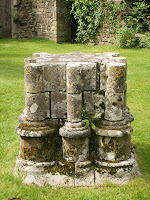
I have been keeping more than a little busy over the past two days. I made a recent decision that if I was going to use the oven, then I would have a big baking session once a week and try and cook that night's meal and a couple of other things to go in the freezer, so that it used the energy most efficiently. So yesterday I made two cakes (Chocolate Cinnamon cake and Tipsy Pear Mincemeat cake - using up my last jar of home-made mincemeat from last Autumn), a dozen Apple and Blueberry muffins, two and a half apple/apple and rhubarb crumbles and our evening meal. I'll post the cake recipes over the weekend. No photos though as I forgot.
Yesterday my husband and I (gosh, I sound just like the Queen!) went to Margam Antiques Fair to meet up with some friends of ours from our Dorset days. We had our usual lovely long chat, and I took some photos of the abbey ruins whilst we were there. Margam Park must have been SUCH a wonderful place to live in its heyday. Now it belongs to the Council and the house is sadly a shell, though you can go into the back entrance hall and gaze in awe at the wonderful staircase. You can catch a glimpse of it if you use this link (which will also lead you to the full history): http://www.neath-porttalbot.gov.uk/margampark/castle.cfm
There are some 850 acres of parkland belonging to the estate, and Bronze Age and Iron Age remains have been found in the area. There is a splendid herd of deer, who may well be descendants of deer introduced by the Romans. (We bought some some venison - an entire deer - from here last November). The Norman abbey, now in ruins, was founded in the 12th century and only the wonderful circular Chapter House remains to show how superb the architecture had been. Of course, the Dissolution of the Monasteries was responsible for its downfall and subsequent ruin.

There have been a number of different houses on the site, but the current one is a Tudor Gothic mansion built between 1830 and 1840, and the Orangery, where we were today, dates from the late 18th century (work began on it in 1787) to house the large collection of orange, lemon and citron trees of Thomas Mansel Talbot, who inherited the estate around this time. In winter, the Orangery was heated by coal fires with chimneys which were set into the back wall.

This was in the wall of the Chapter House, and I think had a quatre-foliate design in the centre, now sadly eroded by wind and rain.
 One of the beautiful bases for the pillars.
One of the beautiful bases for the pillars. A long view of the circular Chapter House.
A long view of the circular Chapter House. Soaring windows.
Soaring windows. The central column which once supported the fan arches of the ceiling.
The central column which once supported the fan arches of the ceiling. Ivy reclaims the stonework.
Ivy reclaims the stonework. Valerian colonises every crack, but looks so beautiful .
Valerian colonises every crack, but looks so beautiful .
The fan vaulting which has stood for 800 years.


2 comments:
Instead of doing my roundtrip in Greece I should have done one around the UK, lol ! At least there I am sure that people are friendly to foreigners not like the Greeks with the tourists and when I look at your pictures it's really worthwhile to see all these places. I only know London and the South East coast.
Margam Castle must have been magnificent in its heyday which I imagine must have been the Edwardian era and the 1920s. The ruins of the monastery are beautiful too especially that fan vaulting. I always think that it's so sad when these old mansions stand empty and unloved.
Post a Comment